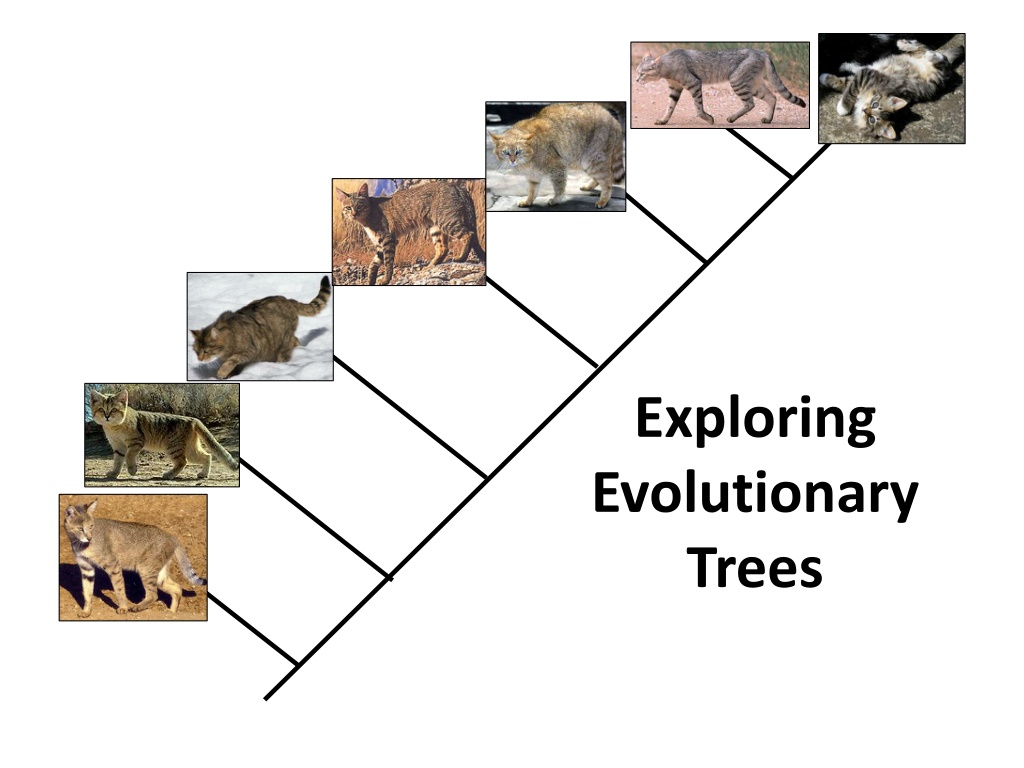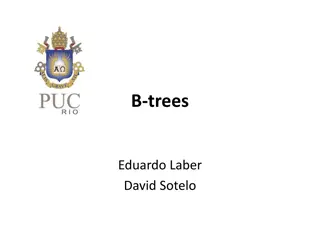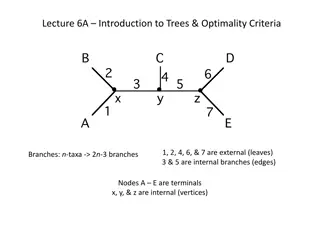Exploring Evolutionary Trees and Family Lineages
Dive into the world of evolutionary trees and family lineages through captivating visuals and informative illustrations. Explore the relationships between species, understand genetic connections, and discover how traits evolve and spread through generations. From evolutionary history to family trees, this content provides an intriguing insight into the interconnectedness of life forms.
Download Presentation

Please find below an Image/Link to download the presentation.
The content on the website is provided AS IS for your information and personal use only. It may not be sold, licensed, or shared on other websites without obtaining consent from the author. Download presentation by click this link. If you encounter any issues during the download, it is possible that the publisher has removed the file from their server.
E N D
Presentation Transcript
Exploring Evolutionary Trees
Family trees 1st Cousin once removed Great aunt Second cousin 1st Cousin once removed Aunt Brother Great Grandmother Mother You Sister grandmother Aunt Cousin Second cousin Great uncle 1st Cousin once removed Second cousin
Family trees 1st Cousin once removed Great aunt Second cousin 1st Cousin once removed Aunt Brother Great Grandmother Mother You Sister grandmother Aunt Cousin Second cousin Great uncle 1st Cousin once removed Second cousin
Family trees 1st Cousin once removed Second cousin 1st Cousin once removed Aunt Brother Mother You Sister Aunt Cousin Second cousin 1st Cousin once removed Second cousin
Evolutionary trees Species 1 Species 2 Species 7 Species 3 Species 4 Species 5 Species 6 Species 8 Species 9
Near Eastern Wildcat Domestic Cat Chinese Desert Cat S African Wildcat European Wildcat Sand Cat Trees show you which species are most closely related Jungle Cat
Near Eastern Wildcat Domestic Cat Chinese Desert Cat S African Wildcat European Wildcat Dry habitat Cold habitat Dry & cold Sand Cat Jungle Cat Trees can tell you if certain traits are more common in specific environments
Near Eastern Wildcat Domestic Cat Chinese Desert Cat S African Wildcat Stocky body European Wildcat Sand Cat Stocky body Trait changes can be drawn on the tree to show where they evolved Jungle Cat Stocky body
Near Eastern Wildcat Domestic Cat Chinese Desert Cat S African Wildcat Lean body European Wildcat Stocky body Sand Cat Lean body Goal: minimize the number of changes = parsimony Jungle Cat Stocky body
Lets practice Pine Trees Flowering plants Ferns Mosses Flowers Seeds Vascular tissue
How did these color patterns arise? New World Orioles come in shades of yellow and orange with contrasting black Sometimes males and females look the same, other times different Altimira Oriole Baltimore Oriole Authors question: Which came first, bright females or dull females? Hofmann et al. 2008
How did these color patterns arise? New World Orioles come in shades of yellow and orange with contrasting black Sometimes males and females look the same, other times different Altimira Oriole Baltimore Oriole Brainstorm: How could bright colors be adaptive for a bird? How could bright colors be costly? Hofmann et al. 2008
Published Tree Yellow Oriole Altimira Oriole Black-backed Oriole Baltimore Oriole yellow-orange (F) yellow-orange (M) light yellow (F) orange (M) bright yellow (F) black back (F) Yellow-backed Oriole Audubon s Oriole black back (F) Scott s Oriole bright yellow (F)
Published Tree Yellow Oriole Altimira Oriole Black-backed Oriole Baltimore Oriole yellow-orange (F) yellow-orange (M) light yellow (F) orange (M) bright yellow (F) black back (F) Yellow-backed Oriole Audubon s Oriole black back (F) Scott s Oriole Female color has gotten brighter 4 different times and duller once bright yellow (F) .but male color only changed once
Published Tree Yellow Oriole Altimira Oriole Black-backed Oriole Baltimore Oriole yellow-orange (F) yellow-orange (M) light yellow (F) orange (M) bright yellow (F) black back (F) Yellow-backed Oriole Audubon s Oriole black back (F) Scott s Oriole bright yellow (F) Female ancestor: medium yellow, gray back
Trees can be tools for testing why traits evolved Yellow Oriole (bright yellow F) Altimira Oriole (yellow-orange F) Black-backed Oriole (light yellow F) Baltimore Oriole (medium yellow F) Audubon s Oriole (bright yellow F) Yellow-backed Oriole (bright yellow F) Scott s Oriole (medium yellow F) species migrates species doesn t migrate
Why do we tend to find bright colors in non-migratory females? less social competition more social competition
Recap Evolutionary trees are similar to family trees and show descendants from a common ancestor
Recap Evolutionary trees are similar to family trees and show descendants from a common ancestor Evolutionary trees show which species are most closely related
Recap Evolutionary trees are similar to family trees and show descendants from a common ancestor Evolutionary trees show which species are most closely related Evolutionary trees are used by biologists to determine when particular traits evolved
Recap Evolutionary trees are similar to family trees and show descendants from a common ancestor Evolutionary trees show which species are most closely related Evolutionary trees are used by biologists to determine when particular traits evolved Trees built using more data are more accurate- gene sequences are the best
Recap Evolutionary trees are similar to family trees and show descendants from a common ancestor Evolutionary trees show which species are most closely related Evolutionary trees are used by biologists to determine when particular traits evolved Trees built using more data are more accurate- gene sequences are the best Evolutionary trees can be combined with environment or lifestyle data to test hypotheses for why traits might have evolved























